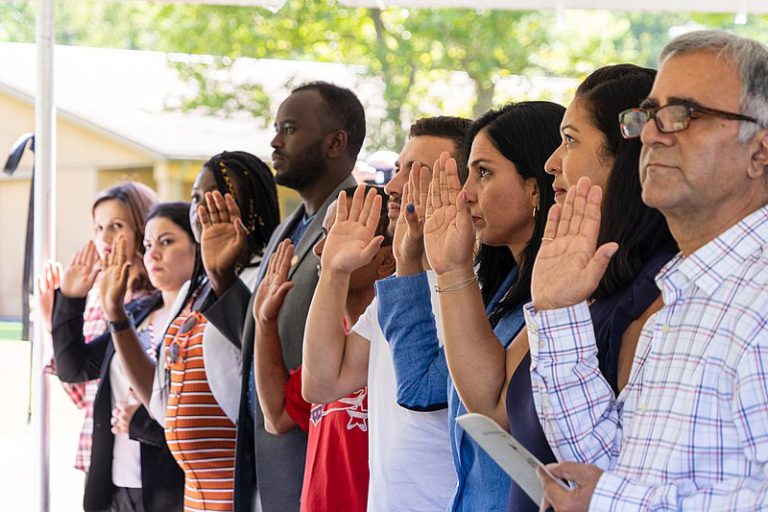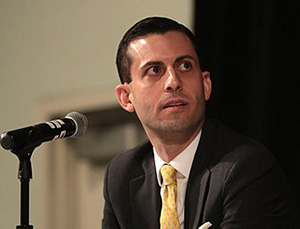
Most of the oxygen in the national debate on U.S. immigration policy is taken up by illegal immigration. Our preoccupation with the undocumented population, experts say — from apprehensions and deportations to the border wall — distracts us from the most central question for reimagining our federal immigration policy: How many people do we want to legally let into the country every year?
In anticipation of a post-election landscape, Ideaspace sought an answer to this question from immigration policy thinkers across the political spectrum. All of them, even those on the conservative side, wanted to shift the focus of our debate away from how to handle illegal behavior toward how to regulate legal immigration.
 “Most of the restrictionists I know would be happy to exchange amnesty for cuts in legal immigration,” says Mark Krikorian, executive director of the Center for Immigration Studies, a leading think tank in the country’s immigration reduction movement.
“Most of the restrictionists I know would be happy to exchange amnesty for cuts in legal immigration,” says Mark Krikorian, executive director of the Center for Immigration Studies, a leading think tank in the country’s immigration reduction movement.
When it comes to how to handle the more than 11 million undocumented immigrants currently residing in the country, very few conservative lawmakers and policymakers see wholesale deportation as a possible solution. However, conservatives have resisted legalizing the undocumented in part because it gives them leverage for obtaining increases in border security or, as Krikorian suggests, cuts in legal immigration.
While left and right disagree on what the nation’s legal immigration priorities should be, both sides concur that the current system is in dire need of reform.
“Our immigration laws have not been updated since 1990,” says Stephen Yale-Loehr, co-author of Immigration Law and Procedure and Professor of Immigration Law Practice at Cornell University. “But just as important, they haven’t been reconceptualized. So we’ve just tacked on different ideas. One idea applies to this visa category but not another. It would be great if Congress started from scratch and asked the question: What sort of immigration system should we have for the 21st Century?”
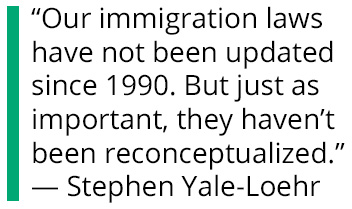
Imagining a possible overhaul of the nation’s immigration system starts with understanding the current landscape. In 2018, the U.S. granted permanent residency to 1,096,611 people, according to the Department of Homeland Security. Just over 63 percent of these “green cards” were issued because of a familial relationship; the rest were granted through various programs including the diversity lottery, visas for individuals with “extraordinary abilities”, asylum and refugee resettlement. There is even the EB-5 visa, which allows an individual to buy permanent residency status through a $900,000 investment in an American business; just under 10,000 were issued in 2018.
The aggregate totals for these “green card” programs have been relatively stable for the last four decades; while there are a few outliers (644,787 in 1999, 1,826,595 in 1991), the annual totals have generally been not far on either side of a million.
“A million people seems like a lot in abstract terms,” says Yale-Loehr, “but when you put it in the context of 330 million people in the country — not so much. And we certainly take fewer immigrants per capita than a lot of countries such as Canada.”
But there is another part to the story. The 1,096,611 green card number for 2018 does not include individuals who were granted entry into the country on a temporary basis. These temporary visas are of intense interest to many Americans because they authorize the entry of most of the foreign workers who come to the U.S. every year. These workers are issued “nonimmigrant visas” that allow them (and sometimes their nuclear families) to enter the country and stay for a fixed period, often with the possibility to renew the visa and, in some cases, graduate to permanent residency status. While the number of nonimmigrant visas issued to foreign workers fluctuates from year to year, the fluctuation is around a number far larger than the number of green cards. The math for 2018 is illustrative. For that calendar year the number of nonimmigrant visas for foreign workers and their families was 3,919,567, nearly four times the number of green cards.
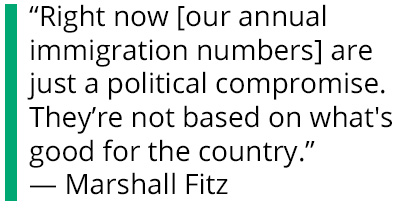
Across all visa categories there are significant variations when it comes to how each is administered. Some categories exist for only a few years; others have been around for generations. Some have caps while others do not. There are, for example, annual limits on admission of refugees (those who are still in the homeland they need to flee) but international law prohibits caps on asylum seekers (those who have already fled their homeland and seek asylum after reaching a U.S. port of entry). Certain visas have waiting periods that extend not just weeks and months but years or even decades. For siblings of U.S. citizens who came from Mexico and the Philippines, the “line” to get into the country is currently about 20 years long.
In 2018, our immigration system was composed of hundreds of distinct visa categories. It is a collection of exceptions and rules patched together over several generations — a slow-moving assemblage of densely interwoven components, a bureaucratic Frankenstein.
While the executive branch sets the priorities and interprets rules for federal agencies like United States Customs and Immigration Services, it is the responsibility of Congress to write and pass legislation that would reform the system. Unfortunately, congressional understanding of the system is limited. The rationale for categories and caps that exist today is often far from clear. Marshall Fitz, managing director of the immigration department at Lauren Powell Jobs’s Emerson Collective, says the system is completely “arbitrary.”
“Right now those numbers are just a political compromise,” Fitz says. “They’re not based on what’s good for the country.”
Fitz and other immigration experts believe that, instead of depending on Congress to determine the numbers admitted under the vast medley of categories, a non-political entity made up of experts should on a regular basis be opining on or perhaps even resetting those top-line limits.
“A Department of Immigration,” he says, “could be tasked with studying changing economic conditions, labor demand, and population trends in different parts of the country.”
Fitz also calls for considering external factors, like violence in Central America’s Northern Triangle and fluctuating birth rates in Mexico, to determine the number of people who want to immigrate.
Like many of his pro-immigration colleagues, however, Fitz stops short of giving a hard number as an annual goal for the U.S.; in his model, such a figure is a moving target.
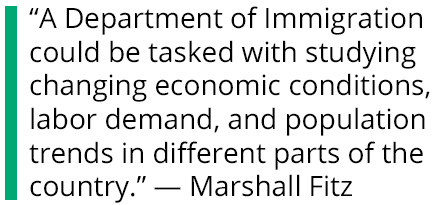
Immigration restrictionists like Krikorian believe such talk provides cover for those who favor unlimited immigration. In Krikorian’s view, there are only two basic starting points when it comes to building an immigration system: one, unlimited immigration with exceptions for those who pose a criminal or terrorism threat and, two, zero immigration with exceptions for the spouses and children of U.S. citizens, and a very limited number of other exceptions, such as those for so-called genius visas, asylum recipients (“asylees”), and refugee resettlements.
“My take is on the latter [starting point], that no one in the world has a right to come here,” he says.
When Krikorian adds up his exceptions, he does arrive at a solid number: 400,000 people. That’s roughly 350,000 for green cards for marriages and children of U.S. citizens born outside the country, 25,000 for individuals with “extraordinary abilities” — or, as Krikorian calls them, “true Einstein visas” — and 25,000 for asylees and refugees.
Roy Beck, president of NumbersUSA, another organization that advocates for low immigration, arrives at a similar number when allowing for “the individual liberty issue of an American being able to fall in love with someone overseas.”
Beck’s number is in the vicinity of 550,000. He believes our immigration system should consider cultural dynamics, including the virtues and problems of ethnic and linguistic diversity. “With large masses of immigration, you do have real issues of assimilation,” he says. “Communities can be overwhelmed. Their systems can be overwhelmed in terms of their ability to assimilate.”
Krikorian makes a similar argument, and contends that cheap and easy travel and telecommunications have a major impact. “Today, unlike 100 years ago, you can live in two countries at the same time,” he says. “And that’s a good thing. I’m all for it. Skype and [low] airfare. But it complicates assimilation because it retards the process of a foreigner reorienting his psychological and emotional commitments from one place to another place.”
For Beck and Krikorian, their restrictionist views are grounded in a belief that immigration at its present levels depresses wages and employment opportunities for native-born workers. They also contend that massive inflows of low-skilled immigrants are a drain on public services, meaning they take more in benefits than they contribute in taxes.
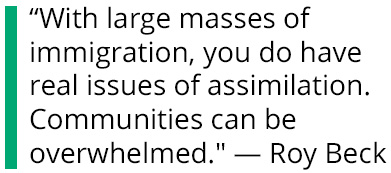
As for the latter charge, Alex Nowrasteh, director of immigration studies at the Cato Institute, the libertarian think tank, asserts that such views are not supported by empirical data. “There’s a bunch of big studies that find that immigration is a net positive,” says Nowrasteh, “and there’s basically almost none that find that it’s a negative. … Immigrants, on average, contribute more in taxes than they’ve taken [in] benefits.”
This consensus animates an April 2017 letter to Pres. Trump and congressional leaders, signed by 1,470 prominent economists, including six Nobel Prize winners, which begins, “The undersigned economists represent a broad swath of political and economic views. Among us are Republicans and Democrats alike. Some of us favor free markets while others have championed for a larger role for government in the economy. But on some issues there is near universal agreement. One such issue concerns the broad economic benefit that immigrants to this country bring.” The signatories go on to highlight how immigrants increase the country’s access to a diversity of skill sets, youth and entrepreneurship, all of which drive the economy. In 2018, immigrants who were lawfully in the U.S. paid more than $458 billion in taxes and brought over a trillion dollars in spending power to the U.S. economy.
In keeping with his pro-immigration colleagues, Nowrasteh will not put a number on the optimal amount of annual immigration, as he sees the number fluctuating with the economy and the decision-making of individuals. As for how much immigration the country could bear if restrictions were lifted, he believes the number is limitless.
“Let’s say it’s an additional 500 million over the course of 10 years,” says Nowrasteh. “What will happen immediately is the price of housing will rise. That will stimulate more housing construction. Wages would adjust. These immigrants who come will be taxpayers, businesses, investors, consumers. Everybody will change their behavior a little bit due to this expected increase in the population, such that the economy can adjust pretty easily.
“And as far as infrastructure is concerned, the worst thing you can do with infrastructure is have fewer people using it,” Nowrasteh continues. “That’s what we had in New York in the 1970s when the population declined. So people aren’t just consumers of infrastructure, they’re also taxpayers who use the infrastructure.
“One of the best things a free market system does is it handles pretty quickly massive increases in demand for goods and services,” says Nowrasteh.
Even with a prevailing academic consensus that immigrants play a positive role in the economy, Americans struggle with understanding the benefits. It’s easy to see why. It only takes the story of one displaced IT specialist or one factory worker in a local media market to tell a very different narrative, one that pits immigrant labor against native-born workers.
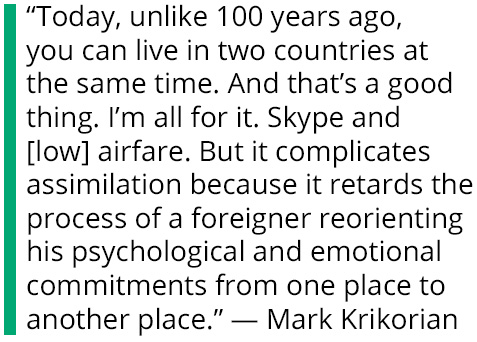
“It’s very clear that on a macroeconomic level immigration benefits the United States,” says Yale-Loehr, “but on the micro-level … people hear stories about their friend who was replaced by a foreign worker, they think, ‘Oh, immigration is bad.’ It’s easier for people to feel better about immigration when the economy is booming as opposed to when we’re in a recession. Also, when leaders are praising immigration or trying to portray immigrants as ‘rapists and thugs’ — that’s a big part of it, too. It matters what leaders are saying and how they’re trying to educate the public.”
Stabilizing the context for a national discussion of the optimal immigration level is itself a challenge. Empirical analysis is necessarily backward-looking and takes as its context what actually happened, not what might have happened. Also, much of what has actually happened in the U.S. in recent decades reflects the power of our capitalist economy to draw in undocumented workers when the flow of legal immigrants doesn’t meet workforce demand. Recent decades have also compelled anyone trying to analyze American immigration and workforce needs to pay steadily rising heed to a vibrant global economy. The country’s workers compete in a globalized labor market whether they want to or not. Capitalism has done a good job of freeing up markets for companies so that they can move operations to lower labor costs but workers have yet to experience the freedom of movement enjoyed by so many of their employers.
“The bargaining power of people has gone down with globalization,” says Giovanni Peri, Professor of Economics at UC Davis. “And the U.S. gives a lot of power to the employer, there is no doubt about that, I would say. Look at Europe, look at some other places and there are institutions and protections. In the U.S., still the employer is very much in control. The employer sometimes uses globalization to his own favor, saying, ‘Well, I’m going to outsource these elsewhere so take this worse condition.’ But on the other end, the worker should be able to also use this to their advantage.”
Peri suggests that for native-born workers to see themselves in the same struggle as foreign-born workers, to be open to immigrant workers as potential allies, it’s important not to frame the discussion in zero-sum terms. “This idea of the displacement,” he says, “to me is really mainly rooted in a very simplistic and fictional idea, which is there is a fixed number of jobs.”
Peri says that pitting immigrant workers against native-born workers ignores several essential factors including the economic growth — including job market growth — that immigrants bring to the economy. In 2018, immigrant entrepreneurs employed nearly 8 million workers and made $1.3 trillion dollars in sales.
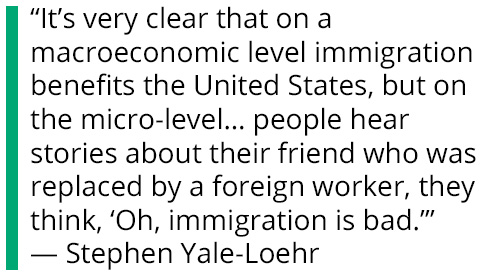
Peri also notes that the type of work Americans do is always evolving. “Very few Americans are agricultural workers in the fields anymore,” he says. “Very few Americans are cleaning houses of other Americans. Very few Americans are assisting the elderly. But it doesn’t mean that those [American workers] were displaced. Many of them just changed jobs.”
This dynamic has a direct relationship to the changing nature of work in the 21st century, where careers are not so much defined by 30 years with one company. Today, many workers have multiple jobs over the course of their lifetime, working for several employers — sometimes in distinctly different fields. Factory workers, originally trained on 20th century assembly lines, have retooled with skills to repair wind turbines and install solar panels. The gig economy has taken many workers in the direction of employers like Uber or Lyft, or fielding customer service calls from the worker’s home office for things like e-commerce and subscription services.
Another factor that should be considered in determining the optimal level of immigration is that the country’s birth rate has been dropping for more than a decade and the aging Baby Boomer generation represents an outsized portion of the national population. This means that the native-born workforce is shrinking and seems unable to meet the aggregate demand of our economy. If this conclusion is correct, the labor market in America doesn’t just get a net benefit from immigrants — it requires them. “If you go where there are a ton of immigrants,” says Peri, “they are in San Francisco, they are in Los Angeles, they are in New York, they are in Austin. They’re in places where there are a lot of opportunities. And if you look at which cities have grown the most in terms of employment for Americans, those are the cities which also have grown the most in employment for immigrants.”
But beyond raw jobs numbers, Peri and many immigration specialists acknowledge that there is still much work to be done with regards to the quality of wages and general protections for workers — foreign and native-born. “Enforcement of labor standards, enforcement of labor laws,” Peri says, “I think is crucial and we don’t have enough.”
Peri points out that some of the current visa programs — most notably the HB1 visa which is so widely used in the tech industry — bind a worker to just one company. “If you are hired from a company and you are linked to that company,” he says. “This is a huge source of abuse. Once you are in this country, hired by a company, if you get an offer from any other person, you should be able to move. The initial sponsorship should come from an employer but as soon as you are in this country you should be able to tap into the global labor market. … You need [a system that issues] a permit, which is moveable with the worker, not in the hands of the employer … give workers the power by making it mobile, by making it transferable.”
This mobility for foreign workers — who are in the U.S. on temporary visas — benefits all workers, including Americans, because when a portion of the workforce loses mobility it suppresses competition for labor, which, in turn, suppresses wages.
Stephen Yale-Loehr agrees that new immigration policy needs to prioritize more rights for all workers and stronger enforcement of labor laws. The Fair Labor Standards Act, he points out, applies to all workers in the U.S., native and foreign-born. But a recent study from the Department of Labor showed there are not enough inspectors to cut back on violations, which has resulted in 37 percent of workers in the U.S. being underpaid.
In order to design a new immigration system — a system for the 21st Century, as Yale-Loehr put it — there is a strong argument for starting from scratch and there are several points of consensus regarding what a new, simplified approach might look like.

Beyond the individual liberty that Beck and Krikorian cite — the freedom to marry and adopt overseas — there is also a broad consensus that we need to rethink the current proliferation of permanent residency possibilities for extended family members. Advocates across the political spectrum suggest that a new policy model could allow extended family members into the country with visas that allow them to live with their loved ones but not necessarily gain residency status — that is, access to things like employment and social services. There is recognition that having access to extended family can improve the economic success of individuals who are already in the country — by providing child care or support for an entrepreneurial endeavor. Beck says that while he would limit permanent visas to spouses and children of U.S. citizens, he would not deny the ability of parents and grandparents to visit on temporary visas. “Parents would be able to come and go as they wished,” he says, “as long as they obeyed the provisions of their visas.”
Peri suggests that the foundation for new immigration policy should be market driven. He starts with a simple question: “What inflow of immigrants will, essentially, for the next few years, keep the labor force constant? The labor force is shrinking in the U.S. and is shrinking at a rate of half a percentage point every year. Half a percentage point of the labor force is, I would say, 600,000 – 700,000 people every year.” He suggests that an annual inflow of immigrants could go as high as 1 percent of the labor market, which would add approximately a million and a half workers every year. These would continue to be temporary visas offered on a renewable basis, and these immigrants would be in addition to the visas issued to family members of U.S. citizens and in various other categories.
Peri emphasizes that welcoming different types of workers is essential, and he’s confident that if the labor market is determining what the composition of foreign workers looks like, it will produce a range of education levels and skill sets.
Another popular idea is the implementation of a point-based immigration system. It is not a new idea in global terms — plenty of countries already use a point system of some kind, from China to Australia to Canada. In the U.S. it is an idea that has had bipartisan support for at least four decades. Donald Trump, famously wary of immigrants, advocated for a point system throughout his administration.
The idea behind this approach is that each individual wishing to enter the U.S., either on a temporary visa or with permanent status, would go through the same evaluation process to determine how they might add to the quality of the U.S. economy, culture, and society. Point categories could account for factors such as skills, experience, identity, resources, and the need for safety — just to name a few. The categories do not need to be fixed but can be adjusted periodically to account for changing dynamics within the U.S. and abroad.
Yale-Loehr spent two years working on a July 2020 report entitled “Recruiting for the Future: A Realistic Road to a Points-Tested Visa Program in the United States,” and he says, “You can set up points for anything you want. In the system we came up with we suggested offering points if you’re a woman, or if you come from a developing country. Traditional point systems would be biased toward white males from European countries. It’s easier for someone in Europe to have a PhD than someone in Africa. So the question is how do you overcome that? No system is going to be perfect but the point system is definitely something to consider.”
The report that Yale-Loehr generated recognizes that any reimagining of our immigration policy needs to be rolled out slowly and on a small scale at first, to test its efficacy. The report suggests beginning with a pilot program, authorized for 10 years. Every year the number of green cards issued under the program would increase by no more than 4 percent.
Yale-Loehr argues that an incremental approach, one that starts small but carries sweeping potential, is far more politically plausible than asking Congress to tackle the matter of a lasting comprehensive bill right away. He is hopeful that a pilot program could grow, especially if it is designed to remain fluid and responsive to geopolitical and economic dynamics. “I don’t think you’re ever going to make an easy system for any country,” he says, “but with a point system I think we could at least make something that is more transparent for employers, Americans, and potential immigrants.”
The next congress will have no shortage of big issues to tackle — COVID-19, the economy, healthcare — and immigration touches them all. With any real compromise on illegal immigration policy proving so intractable for decades now, re-shaping our legal immigration policy could offer more opportunity for consensus. Advocates on both sides of the issue agree that the current system, with arbitrary caps and dense bureaucracy, is crying out for reform. There is robust research demonstrating that immigration, as we know it today, has a net positive effect on the national economy, and across the political spectrum there is agreement that a new system should better protect the rights of all workers. There will never be a settled, pie-in-the-sky number of people who should be given residency in the country every year; what really matters is building a modernized, simplified process, flexible with shifting circumstances, guided by clearly stated priorities.
